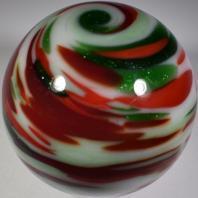-
Posts
682 -
Joined
-
Last visited
-
Days Won
1
Content Type
Profiles
Forums
Gallery
Events
Everything posted by Shamrock Marbles
-
-
Sweet! That is a great story. Thanks for sharing the marble love.❤️
-
Here are some of your pictures from another post: These five should have been in a Header Pack like these: If I recall correctly, you got these from me as part of a Christmas exchange many years ago.
-
Yes, it is a Shamrock. Very early in the learning curve. The first ones had two cut-lines. The second generation had one cut-line. It looks like two cut-lines/seams from your photo. Spectrum stained glass. SP-161 Yellow, SP-209 White/Crystal an SP-125 Green. A couple other examples: Enjoy!!
-
That looks very familiar. 🤔 Merry Christmas! 🔥
-
-
Final follow up: Jack Hahn called me today. He confirmed that Herman C. Leonhardt signed his marbles “HCL”. Jack also stated that Herman only made large marbles (>2” diameter). SCETV: https://www.knowitall.org/video/herman-leonhardt-glassmaker-big-picture
-
Thank you for the heads up! Hang in there!!
-

What was old is new again.
Shamrock Marbles replied to Shamrock Marbles's topic in General Marble & Glass Chat
Fire, I think the unit price was $150. Seems to be a bit steep, but apparently there was an audience/clientele. Personally, I’d prefer the original. 😀 -
-
As a follow up, Royal was referring to a particular marble that Mark Matthews made. The marble was exceptionally large (around 4” diameter) that he named the “Hugo Largo”. It was the top marble in his Population Portrait IX. Population Portrait IX Hugo Largo
-
Steve Davis 08
-
Your Mileage May Vary. https://www.howtogeek.com/693183/what-does-ymmv-mean-and-how-do-you-use-it/
-
At least for the last 25 years, the Guinea market has been for those with deep pockets. It was temporarily eclipsed by the energy and cash inflows for the newly “discovered” “exotics”. As with all collectibles, value is based on a combination of authenticity, uniqueness, desirability and provenance. The Romans used to say, “Caveat emptor.” As always, YMMV.
-
Stumbled across a closed auction on eBay. Posted/sold by Sami (“machinemades”) and closed on 11/09/25. Measuring 21/32” diameter. A couple side views are missing, so I can’t see if it has a gold shamrock mark. Made in 2024-2025 in exploration of “Striped” marbles with single and double cut-lines. Three main white base variants: 1) Green aventurine and Red (Xmas). 2) Green aventurine and Cranberry Pink (Watermelon). 3) Green aventurine and Cobalt Blue (Bluez ‘n’ Greenz).
-
-
To make controlled bubbles in a glass object, you can take a tungsten rake (or any sharp object) and plunge it into the surface. This makes an indentation. To create the bubble, you cap the indentation with glass (air trap). Making a pattern of bubbles can be quite tedious, so some glass workers roll their gather over a bed of nails (flower frog), then plunge it into a pot of hot glass to encase the gather.
-
Hungarian or Bulgarian or somewhere else? Don’t know. Lovely marble regardless of origin. Not picking sides here, but I believe the marble was single gathered and finished off with jacks prior to separation from the punty. Not a torch marble, but a torch was used. The black spots around the pontil mark are from burned dirt/beeswax from the jacks. The gray tone is from the rich gas/oxygen ratio from a finish torch to melt the pontil smooth. At the end of this video, you can see the marble separated and the pontil torch finished… Mark Matthews at Corning As always, YMMV.
-

How Marbles End Up Where They Do
Shamrock Marbles replied to Parmcat's topic in General Marble & Glass Chat
Assuming that all marbles are equal in “attributes” (quantity, pattern, color, size and shape), the distribution of these would follow entropic distribution. Over time marbles would find their way to all “four corners” of the world. Think about an enclosed cube. Spray perfume in a corner and the perfume molecules would ultimately distribute equally in the volume over time. Marbles produced in Ohio would naturally find their way around the world over time. A Christensen Agate Guinea from the 20’s has the same probability to migrate from Ohio to Montreal as it does to Rolla, MO. Now, what changes the distribution is the “value” given to any one or multiple “attributes” involved. Equate money or beauty to gravity or magnetism. “Value” will usually find its way to the deepest purse. Over time, a Guinea found in Canada would probably find its way back into the USA due to the attractiveness of the currency exchange. Well financed collectors disrupt the natural distribution (entropy) of marbles. Their money acts like a black hole and soak up high valued marbles while leaving “lesser” marbles to circulate. (This is not a complaint. Just a reality. They take marbles off the free market and those remaining in circulation become scarce and increase in value. In time, those collectors have their acquisitions released back into public circulation due to disinterest, divestment or death). Stay patient and enjoy the search! YMMV. 😀 -

European Sparkler Orange Peel
Shamrock Marbles replied to Fire1981's topic in General Marble & Glass Chat
Fire, Yes you can. See my post above when I blasted my rollers. They really need to be machined. -

European Sparkler Orange Peel
Shamrock Marbles replied to Fire1981's topic in General Marble & Glass Chat
Easier said than done. The best way is to resurface the augers in a CNC Lathe. $$$$ Most people have a dream, but their wallet falls short. -
Beautiful!!
-

European Sparkler Orange Peel
Shamrock Marbles replied to Fire1981's topic in General Marble & Glass Chat
Here are photos of “weathered” rollers with “patina”. Imagine the marble surface after rolling across these! -

European Sparkler Orange Peel
Shamrock Marbles replied to Fire1981's topic in General Marble & Glass Chat
Size of the glass gob: Since the basic shape of a marble is a sphere, let’s use the radius (r) as a basic unit of measure. Thus the larger the gob the larger the radius. A molten gob of glass is a fluid and has surface tension. It is surface tension that is basically trying to pull the gob into a sphere. Years ago, this law of physics was implemented in creating lead shot. Look up shot tower. Additionally, this is how dippin dots are made. Yum! The formula that concerns us is: As the radius increases the impact of surface tension is reduced. In other words, the surface tension is 2x stronger with a 3/8” diameter gob than a 3/4” diameter gob. The surface tension is 4x stronger with a 3/8” diameter gob than a 1-1/2” diameter gob. What this means, is that a larger gob of glass will collapse or flatten under gravity than a smaller gob. You can replicate this water droplets. So, imagine a large glass gob landing on a pitted roller. Initially, it will overcome surface tension and collapse and conform to the “volume” of the groove. If the groove surfaces are smooth, then you have a chance at a nice marble surface. If the forming surfaces are pitted, then the glass will be impressed with that profile. Once set, it stays. -

European Sparkler Orange Peel
Shamrock Marbles replied to Fire1981's topic in General Marble & Glass Chat
Thank you, Brian. Couldn’t imagine the amount of elbow grease you used. We need to get together for a marble weekend!



























